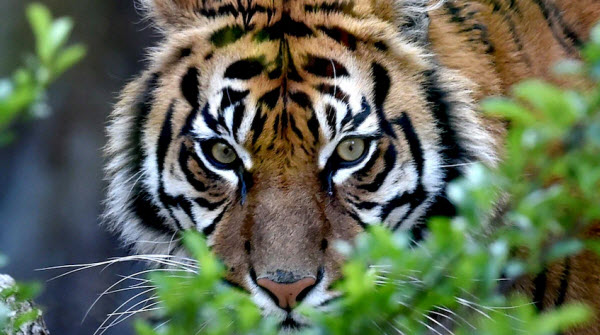Tigers are the largest living species of cats on Earth and are among the most respected wild animals in the world. Their formidable hunting skills are due to their powerful muscles, sleek bodies, and sharp teeth and claws. With their distinctive fur patterns, tigers are well-camouflaged among grasses and trees, allowing them to set up ambushes effectively. Tigers inhabit vast areas, ranging from the eastern part of Anatolia in the west to the Amur River basin in the east, and from the southern slopes of the Himalayas to Bali in the Sunda Islands. Tigers are iconic animals, featured prominently in ancient myths, films, and modern literature, and are often used as symbols for many companies, sports teams, and even as national animals for several countries, such as India and South Korea.
Tiger Subspecies and Their Habitats
There are currently six recognized subspecies of tigers, each living in different environments. These habitats range from flooded mangrove forests and dry woodlands to tropical rainforests and taigas. In the snowy regions of Russia and parts of Asia, the largest subspecies, the Siberian tiger, resides. In contrast, smaller and darker subspecies are found further south in the jungles of Indonesia. Female tigers are generally smaller than males.
- Siberian or Amur Tiger: The largest tiger subspecies, males can be as long as a car. These tigers have pale orange fur with fewer stripes to blend into their snowy environment. Due to their cold habitat, Siberian tigers have longer and thicker fur than other subspecies, along with a layer of fat to keep them warm. Approximately 450 Siberian tigers remain in their native habitats in eastern Russia and northeastern China.
- Bengal or Indian Tiger: The most common tiger subspecies, the Bengal tiger is almost as large as the Siberian tiger. About 3,400 Bengal tigers still inhabit their native regions in India, Nepal, and Pakistan.
- Indochinese Tiger: These tigers are about 20% smaller and darker than the Bengal tiger. Around 250 Indochinese tigers live in Southeast Asia.
- Malayan Tiger: Fewer than 200 Malayan tigers remain in the Malay Peninsula, with only about 80 to 120 adults.
- Sumatran Tiger: The Sumatran tiger, though the smallest tiger subspecies, is still a very large cat. Native to the dense forests of Sumatra, it has longer fur, possibly as protection against forest vegetation. Approximately 370 Sumatran tigers remain in the wild.
- South China Tiger: Slightly smaller than the Indochinese subspecies, this tiger was declared a pest by the Chinese government in the 1950s, leading to widespread hunting. It is now presumed extinct.

Tiger Behavior and Hunting Techniques
Tigers are rarely far from water sources and are excellent swimmers, unlike most other cats. They relax during the day and set up ambushes near ponds, streams, and rivers, often swimming to cool off. Their powerful forepaws are used to take down prey with retractable claws that stay sharp and are used for both catching prey and marking territory by scratching trees.

As patient hunters, tigers can move slowly and quietly to surprise their prey, typically hoofed animals like deer, pigs, rhinos, or elephants in Asia. Tigers use their powerful jaws and large teeth to grab their prey by the neck and choke it. They use their rough, sandpaper-like tongues to scrape the last bits of meat off bones. Tigers kill about once or twice a week, eating as much as they can, then cover the remains with grass and dirt to hide them from vultures before returning to hunt again for smaller meals.

Generally solitary, tigers maintain large territories that can span several square kilometers, depending on habitat and prey availability. Males tend to have larger ranges than females. The Siberian tiger has the largest recorded range, covering over 10,000 square kilometers due to the scarcity of food, necessitating extensive travel for a meal. Some tigers defend their territories against other tigers, while others share the same range.
Reproduction and Raising Cubs
Female tigers mark their territory with urine on trees and other surfaces to inform males of their reproductive status. When mating calls are made, males and females may come together to mate and stay together for a few days before going their separate ways. Cubs are born small and helpless, with up to seven being born every two years, though typically only two or three survive. Cubs stay with their mother until they are about two years old, learning to hunt and fend for themselves.

Threats and Conservation
Tigers face numerous threats due to human activities, such as habitat encroachment and poaching for their fur and body parts, which are used in traditional medicines despite a lack of scientific evidence supporting their effectiveness. In some cultures, tigers are hunted for sport or to prove bravery. With fewer than 4,500 tigers remaining in the wild, significant conservation efforts are needed to ensure their survival. Countries like India have enacted strict laws against killing tigers, and similar regulations have been adopted by other tiger-range nations. International projects are also in place to protect tiger habitats.
Identification Card

- Category: Mammals
- Order: Carnivores
- Family: Felidae
- Species: Panthera tigris
- Lifespan: 14 to 18 years
- Gestation Period: 3.5 months
- Birth Weight: 1 kg
- Maturity: 3 to 6 years
- Number of Offspring: Up to 7, typically 2-3
- Length: 1.5 to 2.9 meters, depending on sex and location
- Weight: 75 to 325 kg
- Tail Length: 0.7 to 1.1 meters
Interesting Facts:
- Each tiger has a unique stripe pattern, much like a human fingerprint, which helps biologists identify individuals.
- Tigers can carry prey twice their weight and drag it up to 3 meters up a tree.
- Tigers have night vision six times better than humans.
This exclusive look into the world of tigers reveals not only their majestic nature and complex behavior but also the urgent need to protect these incredible creatures from extinction.
